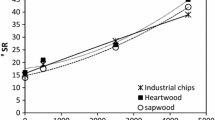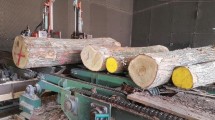Abstract
Specific grinding energy and particle size distribution of grinds are usually used to assess the efficiency of grinding equipment and material grindability. The objective of this study was to quantify the effects of moisture content and storage time on the specific grinding energy of loblolly pine woodchips and the physical properties of the resulting grinds. Samples were ground in a hammer mill fitted with 3.18 and 6.35 mm screen sizes. The specific grinding energy, moisture loss during grinding, particle size distribution, and bulk density of the grinds were measured. Moisture loss during grinding increased with increase in moisture content of woodchips and decreased with increase in hammer mill screen size. Bulk density of grinds reduced from 273.64 to 106.03 kg/m3 and from 251.14 to 131.40 kg/m3 (for 3.18 mm and 6.35 mm hammer mill screen size, respectively), when the moisture content of woodchips was increased from 13.6 to 100.0 % (dry basis). Results also showed that storage time did not significantly affect (p < 0.05) the specific grinding energy. However, specific grinding energy was significantly affected (p < 0.05) by the moisture content of woodchips and hammer mill screen size. The specific grinding energy of woodchips ground through 3.18 mm hammer mill screen size increased with increase in moisture content of woodchips. However when loblolly pine woodchips were ground through 6.35 mm hammer mill screen size, the specific grinding energy initially increased as moisture of woodchips increased from 13.6 to 42.9 % (dry basis), then decreased with further increase in moisture content of woodchips from 42.9 to 100.0 % (dry basis).






Similar content being viewed by others
References
Adapa PK, Tabil LG, Schoenau GJ (2011) Grinding performance and physical properties of non-treated and steam exploded barley, canola, oat and wheat straw. Biomass Bioenergy 35:549–561
Afzal M, Bedane A, Sokhansanj S, Mahmood W (2010) Storage of comminuted and uncomminuted forest biomass and its effect on fuel quality. Bioresources 5:55–69
ASABE (2008) Standard S319.4: method of determining and expressing fineness of feed materials by sieving. St. Joseph Mich.: ASABE
ASTM (2006) AST E871-82. Standard test method for moisture analysis of particulate wood fuels. West Conshohocken, Pa.: ASTM International
Baker JB, Langdon OG (2014) Loblolly Pine. Newtown Square, Pa.: United States Department of Agriculture Forest Service, Northeastern Area. Available at: http://www.na.fs.fed.us/spfo/pubs/silvics_manual/Volume_1/pinus/taeda.htm. Accessed 30 December 2014
Barontini M, Scarfone A, Spinelli R, Gallucci F, Santangelo E, Acampora A, Jirjis R, Civitarese V, Pari L (2014) Storage dynamics and fuel quality of poplar chips. Biomass Bioenergy 62:17–25
Bergström D, Israelsson S, Öhman M, Dahlqvist S, Gref R, Boman C, Wästerlund I (2008) Effects of raw material particle size distribution on the characteristics of Scots pine sawdust fuel pellets. Fuel Processing Technol 89:1324–1329
Bernhart M, Fasina O (2009) Moisture effect on the storage, handling, and flow properties of poultry litter. Waste Manag 29:1392–1398
Bitra VSP, Womac AR, Chevanan N, Miu PI, Igathinathane C, Sokhansanj S, Smith DR (2009a) Direct mechanical energy measures of hammer mill comminution of switchgrass, wheat straw, and corn stover and analysis of their particle size distributions. Powder Technol 193:32–45
Bitra VS, Womac AR, Yang YT, Igathinathane C, Miu PI, Chevanan N, Sokhansanj S (2009b) Knife mill operating factors effect on switchgrass particle size distribution. Bioresource Technol 100:5176–5188
Brand MA, Muniz GI, Quirino WF, Brito JO (2011) Storage as a tool to improve wood fuel quality. Biomass Bioenergy 35:2581–2588
Brandt A, Erickson JK, Hallett JP, Murphy RJ, Potthast A, Ray MJ, Rosenau RJ, Schrems M, Welton T (2012) Soaking of pine wood chips with ionic liquids for reduced energy input during grinding. Green Chem 14:1079–1085
Ghorbani Z, Masoumi A, Hemmat A (2010) Specific energy consumption for reducing the size of alfalfa chops using a hammer mill. Biosystems Engng 105:34–40
He X, Lau AK, Sokhansanj S, Lim CJ, Bi XT, Melin S (2012) Dry matter losses in combination with gaseous emissions during the storage of forest residues. Fuel 95:662–664
Hehar G, Fasina O, Adhikari S, Fulton J (2014) Ignition and volatilization behavior of dust from loblolly pine wood. Fuel Processing Technol 127:117–123
Lewicki PP (2004) Water as the determinant of food engineering properties. A review. J Food Eng 61:483–495
Lin Y, Pan F (2015) Monitoring woody biomass chips quality change during field storage in Michigan. Forest Prod J 65:327–336
Lopo P (2002) The right grinding solution for you: roll, horizontal or vertical. Feed Management 53:23–26
Maghrour A (2009) Motivations incentives and risks of investment in biofuels. Social Sciences Research Network. Available at http://papers.ssrn.com/sol3/papers.cfm?abstract_id=2196644. Accessed 30 November 2013. Rochester NY
Mani S, Tabil LG, Sokhansanj S (2004) Grinding performance and physical properties of whet and barleys straws, corn stover and switchgrass. Biomass Bioenergy 27:339–352
Meng J, Park J, Tilotta D, Park S (2012) The effect of torrefaction on the chemistry of fast-pyrolysis bio-oil. Bioresource Technol 111:439–446
Miao Z, Grift TE, Hansen AC, Ting KC (2011) Energy requirement for comminution of biomass in relation to particle physical properties. Ind Crops Prod 33:504–513
Naimi LJ, Sokhansanj S, Bi X, Lim CJ, Melin S (2012) A study on the impact of wood species on grinding performance. ASABE Paper No. 121337659. St Joseph, Mich.: ASABE
Naimi LJ, Sokhansanj S, Womac AR, Bi X, Lim CJ, Igathinathane C, Lau AK, Sowlati T, Melin S, Emami M, Afzal M (2013) Development of size reduction equations for calculating energy input for grinding lignocellulosic particles. Appl Eng Agric 29:93–100
Passarini L, Malveau C, Hernandez RE (2014) Water state study of wood structure of four hardwoods below fiber saturation point with nuclear magnetic resonance. Wood Fiber Sci 46:480–488
Phanphanich M, Mani S (2011) Impact of torrefaction on the grindability and fuel characteristics of forest biomass. Bioresource Technol 102:1246–1253
Pochi D, Civitarese V, Fanigliulo R, Spinelli R, Pari L (2015) Effect of poplar fuel wood storage on chipping performance. Fuel Processing Technol 134:116–121
Probst KV, Ambrose RPK, Pinto RL, Bali R, Krishnakumar P, Ileleji KE (2013) The effect of moisture content on the grinding performance of corn and corncobs by hammermilling. Trans ASABE 56:1025–1033
Ramachandriya KD, Wilkins M, Pardo-Planas O, Atiyeh HK, Dunford NT, Hiziroglu S (2014) Simultaneous saccharification and fermentation of Eastern redcedar heartwood and sapwood using a novel size reduction technique. Bioresource Technol 161:1–9
Rhodes M (2008) Introduction to Particle Technology. John Wiley and Sons, 2nd edition West Sussex, England
Rupar K, Sanati M (2004) The release of terpenes during storage of biomass. Biomass Bioenergy 28:29–34
SIS (2006) Standard CEN/TS 15148: Solid biofuels—method for the determination of the content of volatile matter. Swedish Standards Institute, Stockholm
Sluiter A, Hames B, Ruiz R, Scarlata C, Sluiter J, Templeton D (2008) Determination of Ash in Biomass by Laboratory Analytical Procedure, National Renewable Energy Laboratory Report No NREL/TP-510-42622. Golden, CO
Soucek J, Hanzlikova I, Hulta P (2003) A fine disintegration of plants suitable for composite biofuels production. Res Agric Eng 49:7–11
Sun Y, Cheng J (2002) Hydrolysis of lignocellulosic materials for ethanol production. Bioresource Technol 83:1–11
Tabil LG, Adapa P, and Kashaninej M (2011) Biomass feedstock pre-processing—part 1: Pre-treatment. In Biofuel’s Engineering Process Technology. Rijeka, Croatia: InTech
Tumuluru JS, Tabil LG, Song Y, Iroba KL, Meda V (2014) Grinding energy and physical properties of chopped and hammer-milled barley, wheat, oat, and canola straws. Biomass Bioenergy 60:58–67
Wadkins J, Shrestha A, Fasina O, Adhikari S, Taylor S (2013) Frictional properties of ground loblolly pine. Auburn Univ J Undergrad Schol 2:26–30
Yazdanpanah F, Sokhansanj S, Lim CJ, Lau A, Bi X, Melin S (2014) Stratification of off-gases in stored wood pellets. Biomass Bioenergy 71:1–11
Zelinka SL, Lambrecht MJ, Glass SV, Wiedenhoeft AC, Yelle DJ (2012) Examination of water phase transitions in loblolly pine and cell wall components by differential scanning calorimetry. Thermochim Acta 533:39–45
Acknowledgments
We gratefully acknowledge funding support from USDA-NIFA Project through the Southeast Partnership for Integrated Biomass Supply Systems (IBSS).
Author information
Authors and Affiliations
Corresponding author
Rights and permissions
About this article
Cite this article
Oyedeji, O., Fasina, O., Adhikari, S. et al. The effect of storage time and moisture content on grindability of loblolly pine (Pinus taeda L.). Eur. J. Wood Prod. 74, 857–866 (2016). https://doi.org/10.1007/s00107-016-1070-x
Received:
Published:
Issue Date:
DOI: https://doi.org/10.1007/s00107-016-1070-x




